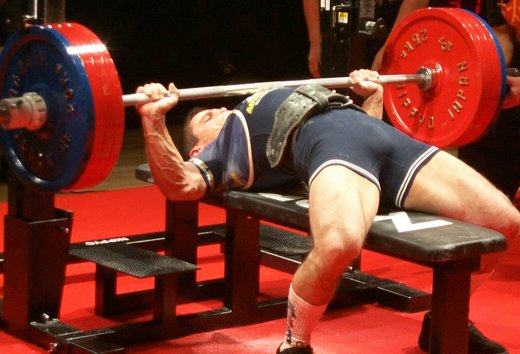

By Peter M. Broady, a physics student at the University of Alaska Fairbanks (11/20/02). Find out more about the creator on the Bibliography page.
Physics 211, Prof. David Newman

Overview of this site:
This site is a student project project in a Physics 211(Newtonian mechanics) class at The University of Alaska Fairbanks. Its intent is to relate basic principles of physics to weightlifting. All of the concepts explained on this site should be simple enough for any non-physics student to comprehend. If you have any questions, you can email me at fspmb@uaf.edu and I will do my best to answer any questions you have about the physics of strength or about me.
There are five links to information in the bar on the left of this page. "The Squat" goes to a page that explains the squat and discusses the physics playing a role in it. "The Bench" and "Deadlift" pages do the same for their respective lifts. The link "Paul Anderson" goes to my page about a little known strength legend named Paul Anderson who performed amazing feats of strength(even by today's standards) more than 50 years ago. His is a fascinating and inspiring story.
I hope you enjoy my site, and maybe also learn something from it. My intent in making this site is to show how fascinating physics is, and also how it affects our everyday lives. I hope that whoever sees the information on this site will be inspired to take a physics class or study physics on their own. Thank you and enjoy.
Sincerely,
Peter M. Broady







Welcome to the Physics of Strength
What make a person strong? According to Frederick Hatfield, Ph.D. and former world record holder in the Squat, there are 38 factors affecting strength. I have put them here for you to read quickly, but the original article can be found on www.drsquat.com.
- Muscle Fiber Arrangement
- Musculoskeletal Leverage
- Tissue Leverage
- Freedom of Movement Between Fibers
- Tissue Viscoelasticity
- Intramuscular/intracellular friction
- Ratio of Fiber Types
- Range of Motion
- Freedom From Injury
- Connective Tissue Structure
- Stretch Reflex
- The Feedback Loop
- Endocrine System Functions (hormones)
- Extent of hyperplasia (cell splitting) or fiber fusion
- Extent of myofibrillarization
- Motor Unit Recruitment
- Energy transfer systems' efficiency
- Extensiveness of capillarization
- Mitochondrial growth and proliferation
- Stroke volume of the left ventricle
- Ejection fraction of the left ventricle
- Pulmonary (ventilatory) capacity
- Efficiency of gas exchange in the lungs
- Heart rate
- Max VO2 uptake
- Freedom from disease
- Arousal Level ("psych")
- Ability to concentrate
- Incentive
- Social learning
- Coordination
- "Spiritual" factors
- The "placebo" effect
- Equipment
- Environment
- Effect of gravity
- Opposing and assisting forces
This pretty much covers everything. As you can see, it takes a culmination of physical, natural, mental, spiritual, and psychological factors to be strong. It also takes time. The laws of physics play a huge role in what it means to be strong. On this site we will focus especially on the last two, the effect of gravity and forces. The physical concepts that will be used in this site include Newton's laws (of course), gravity, work, power, velocity and acceleration, static equilibrium, and conservation of mechanical energy. All concepts and useful equations will be explained as they are used.









